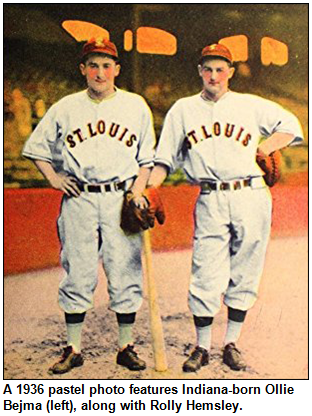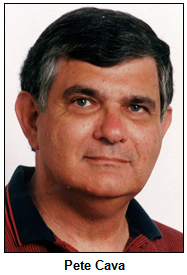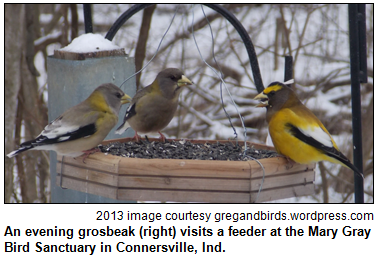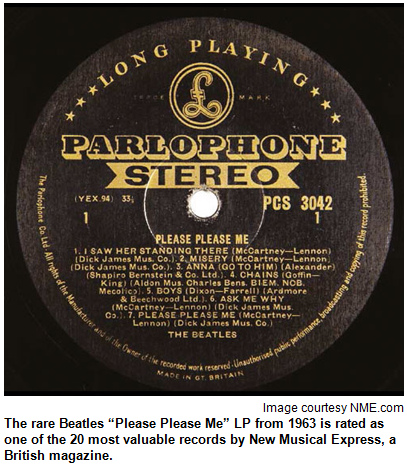Saturdays, noon to 1 p.m. ET on WICR 88.7 FM.
Or listen live from anywhere on WICR
Online!
July 4 show
Colorful Indiana-born baseball players
 A Hoosier from Michigan City pitched the only "perfect game" in a World Series. Another major league baseball player from Indiana, a superstar for the New York Yankees, wore a number on his uniform (23) that symbolized a family tragedy.
A Hoosier from Michigan City pitched the only "perfect game" in a World Series. Another major league baseball player from Indiana, a superstar for the New York Yankees, wore a number on his uniform (23) that symbolized a family tragedy.
And an obscure infielder from South Bend was the answer to a trivia question posed in the popular Peanuts comic strip by Charles Schulz.
They are among the baseball figures we will explore when Nelson is joined by Indianapolis-based sports historian Pete Cava, the author of an upcoming, definitive book titled Indiana-Born Major League Baseball Players: A Biographical Dictionary, 1871-2014 (McFarland Publishing).
So many native Hoosiers have excelled in the major leagues (10 natives of Indiana are enshrined in the Baseball Hall of Fame in Cooperstown, N.Y.) that we can't cover all of the stars in a single show. Instead, we will focus on some of the most colorful anecdotes associated with pro baseball players during our program with Pete, who has had an extensive career writing about baseball and Olympic sports.
His new book, which will be published in the fall, includes an entry about Tommy John from Terre Haute, the former pitcher who underwent a pioneering type of elbow operation that ever since has been known by his name. "Tommy John surgery" has saved the careers of many pitchers, Pete notes.
 The player whose uniform number symbolized a family tragedy was Evansville native Don Mattingly, who created a sensation with his stellar play as a Yankees first baseman during the 1980s.
The player whose uniform number symbolized a family tragedy was Evansville native Don Mattingly, who created a sensation with his stellar play as a Yankees first baseman during the 1980s.
Southern Indiana also was the home turf of a first baseman who Pete contends has been unfairly neglected by the Hall of Fame. Princeton native Gil Hodges (1924-1972) was a hard-hitting first baseman for the Brooklyn (and later Los Angeles) Dodgers.  Then, Hodges managed the New York Mets to a shocking upset in the 1969 World Series. The team has gone down in history as the "Miracle Mets."
Then, Hodges managed the New York Mets to a shocking upset in the 1969 World Series. The team has gone down in history as the "Miracle Mets."
During the 1956 World Series, Michigan City native Don Larsen of the Yankees pitched a "perfect game" that, to this day, is the only one in the history of the World Series.
So who inspired the Peanuts trivia question? A shortstop named Ollie Bejma (1907-1995), a South Bend native who captivated spectators in the 1930s on a short-lived major league team from St. Paul, Minn. More than 35 years later, he was saluted in Peanuts by Schulz, a Minnesota native.
 During our show, Pete also will share insights about an outfielder and manager in the early 1900s who committed suicide in French Lick. The unexpected death of Charles "Chick" Stahl, who killed himself in 1907, has been shrouded in mystery for more than a century. He grew up in Fort Wayne and played for - and managed - Boston-based teams.
During our show, Pete also will share insights about an outfielder and manager in the early 1900s who committed suicide in French Lick. The unexpected death of Charles "Chick" Stahl, who killed himself in 1907, has been shrouded in mystery for more than a century. He grew up in Fort Wayne and played for - and managed - Boston-based teams.
Other major league baseball players that we will explore include:
- George Crowe (1921-2011), the brother of the late Ray Crowe, who coached Attucks High School to back-to-back basketball championships in the mid-1950s. The Crowe brothers grew up in Franklin. George Crowe graduated from the University of Indianapolis (then Indiana Central College) and went on to play for pro baseball teams in Boston, Milwaukee, Cincinnati and other cities. Pete describes George Crowe as "Indiana's version of Jackie Robinson," referring to the legendary player who broke the color barrier in the major leagues.
- Bob Anderson of East Chicago. Anderson (1935-2015), a pitcher, has the distinction, as Pete puts it, of being "on the mound the only time in big league history when two baseballs were in play at the same time." Pete will share details about this bizarre occurrence, which happened in 1959 at Wrigley Field in Chicago.
- And Mattingly, who was born in Evansville in 1961 in a family of athletes. Since retiring as a Yankee player in 1995, Mattingly has remained in the headlines. He currently is the manager of the Los Angeles Dodgers.
Learn more:
Roadtrip: Mary Gray Bird Sanctuary in Connersville
 Guest Roadtripper Terri Gorney of Fort Wayne suggests a visit to the Mary Gray Bird Sanctuary. Owned and operated by the Indiana Audubon Society, the sanctuary is located in Connersville in Fayette County.
Guest Roadtripper Terri Gorney of Fort Wayne suggests a visit to the Mary Gray Bird Sanctuary. Owned and operated by the Indiana Audubon Society, the sanctuary is located in Connersville in Fayette County.
Alice Green Gray gave the initial 264-acre property to the Indiana Audubon Society in 1943 as a living memorial to her daughter Mary, who preceded her in death. Congressman Finley H. Gray willed additional property to the society in 1947, bringing the total to more than 600 acres.
Interestingly, the Grays offered the "Canal House," the headquarters of the Whitewater Canal that passed through Connersville, to the Indiana Audubon Society to sell in order to generate funds for the sanctuary.
Ongoing research at the sanctuary includes three decades of turtle studies, graduate-student research looking for relations between forest plant species and breeding birds, plant populations, Monitoring Avian Populations and Sustainability (MAPS) with bird banding, and hummingbird banding during migrations and breeding seasons. More than 107 ruby-throated hummingbirds have been banded this year at the Mary Gray Bird Sanctuary.
Girl Scouts and Boy Scouts are active with projects at the sanctuary. Projects include bridge building, chimney swift towers for nesting, invasive plant eradication, erosion control and bluebird box installations.
The bird sanctuary is open 365 days a year during daylight hours. There is no set fee; a donation box is located next to the parking lot.
History Mystery
 A long-retired Major League Baseball pitcher from Indiana is known for playing the harmonica. He has played Take Me Out to the Ballgame and other tunes at concerts and sporting events.
A long-retired Major League Baseball pitcher from Indiana is known for playing the harmonica. He has played Take Me Out to the Ballgame and other tunes at concerts and sporting events.
Born in 1926, he played in the Major Leagues from the late 1940s through the late 1950s. He pitched in five World Series, retired at age 32 and moved back to his hometown in Indiana. Last year, he was a guest on Hoosier History Live.
Question: Who is he?
The call in phone number is (317) 788-3314, and please do not try to win the prize if you have won any prize from WICR during the past two months. Please do not call into the show until Nelson has posed the question on the air.
The prize pack includes two tickets to any Indianapolis Indians games this season, courtesy Visit Indy.
Your Hoosier History Live! team,
Nelson Price, host and
creative director
Molly Head, producer, (317)
927-9101
Richard Sullivan, webmaster
and tech director
Pam Fraizer, graphic
designer
Garry Chilluffo, media+development director
Please tell our sponsors that you appreciate their support: B's Po Boy restaurant | Ernie Pyle WWII Museum | Indiana Historical Society | Lucas Oil | Story Inn.

 Acknowledgments to Monomedia, Visit Indy, WICR-FM, Fraizer Designs, Heritage Photo & Research Services, Derrick Lowhorn and many other individuals and organizations. We are an independently produced program and are self-supporting through organizational sponsorships and individual contributions. We do not receive any government funding. Visit our website to learn how you can support us financially. Also, see our Twitter feed and our Facebook page for regular updates.
Acknowledgments to Monomedia, Visit Indy, WICR-FM, Fraizer Designs, Heritage Photo & Research Services, Derrick Lowhorn and many other individuals and organizations. We are an independently produced program and are self-supporting through organizational sponsorships and individual contributions. We do not receive any government funding. Visit our website to learn how you can support us financially. Also, see our Twitter feed and our Facebook page for regular updates.
July 11 show
Vinyl records and albums: play 'em again
Not too long ago, vinyl records and albums seemed to be a chapter (albeit a bulging one) in history.
Stop the music. A comeback is under way for singles and albums on vinyl - the way hit songs performed by entertainers from Frank Sinatra, the Beatles and the Rolling Stones to the Jackson Five, Linda Ronstadt and John Mellencamp were introduced.
 To explore the heyday, decline and recent re-rise of vinyl records and albums, Nelson will be joined in-studio by three Hoosier guests. They include a record collector/seller who has an inventory of more than 250,000 albums and 80,000 singles. He is Larry Landis, who operates Legend Records in the Westfield Antique Mall.
To explore the heyday, decline and recent re-rise of vinyl records and albums, Nelson will be joined in-studio by three Hoosier guests. They include a record collector/seller who has an inventory of more than 250,000 albums and 80,000 singles. He is Larry Landis, who operates Legend Records in the Westfield Antique Mall.
One of our other guests, Rick Wilkerson, reports that sales of vinyl records have been increasing by 50 percent annually in recent years. Rick, the owner of Irvington Vinyl, says vinyl records now account for 6 percent of total music sales, so it's still a relatively small portion.
For about 70 years during the 20th century, though, vinyl was king. Record players and turntables could be found in almost every home. The hi-fi eventually became a standard furnishing, as well.
So our guests also will include John Scot Sheets, the owner of Affordable Hi Fi, who repairs and sells record players and turntables. John also is a musician and songwriter.
According to an article in Senior Life, a monthly newspaper serving the over-50 set in central Indiana, our guest Larry Landis' collection includes "bootleg albums, mint pressings, limited editions and albums that still contain all of the posters, stickers and freebies originally included."
The heyday of vinyl music is now more than 25 years in the past. By the late 1980s, digital media was making significant inroads, with compact discs (CDs) starting to take over.
Despite the continual technological advances, some folks still prefer to listen to albums and records the old-fashioned way; increasing numbers of young people, even teenagers, are joining the crowd. Nelson and his guests will explore why.
His guests also will share insights about which vintage albums and records are in demand. And which are not.
Learn more:
© 2015 Hoosier History Live! All rights reserved.
Hoosier History Live!
P.O. Box 44393
Indianapolis, IN 46244
(317) 927-9101






